Wining and Dining in Charlottesville, Virginia
Home to the Monticello Wine Trail with dozens of wineries, the Charlottesville area is an oenophile’s dream
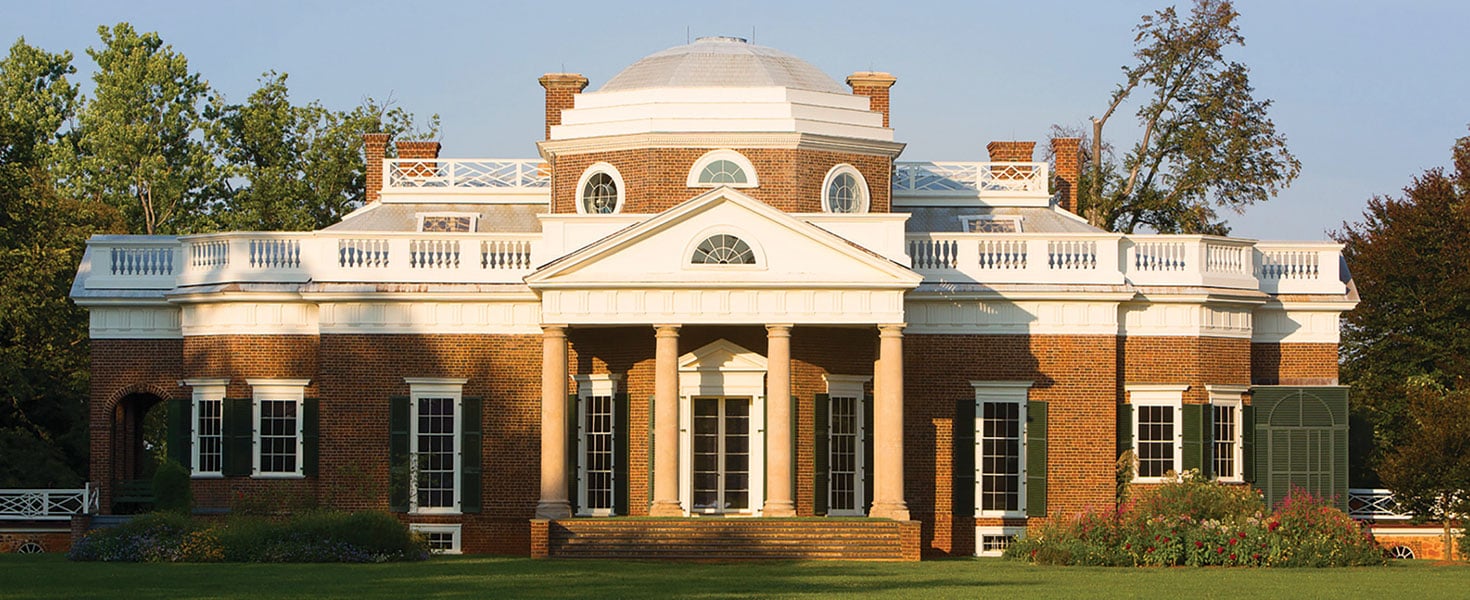
As a traveler who loves wine,I’m driving to Charlottesville on this late-September day to visit Virginia’s wine and culinary capital. The sun’s rays peek over the horizon, lighting the golden fields and wildflowers that flank undulating country roads. In the last 10 miles, I’ve passed a dozen signs for vineyards that point toward long driveways. I make a mental note to check out some of them on my way home.
Wine is, of course, dependent on soil, weather and topography, or terroir. Annette Ringwood Boyd, director of the Virginia Wine Board, describes this area’s wines as more fruit forward and not as “jammy” as West Coast wines. “They tend to have higher natural acidity,” she says. More than half of Virginia’s vineyard acres grow within the Monticello American Viticultural Area. Currently, there are 43 member wineries on the Monticello Wine Trail, all within 25 miles of Charlottesville—an oenophile’s dream destination.
To help plan my itinerary, I consulted monticellowinetrail.com, the website of the trail named for the home of Charlottesville’s former resident Thomas Jefferson. More than 200 years ago, our third president attempted to grow grapes here.
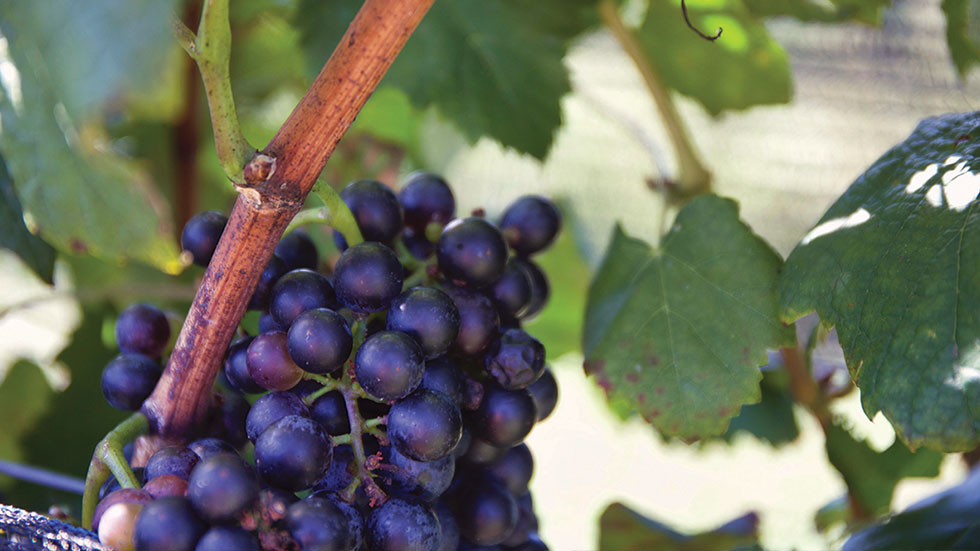 Fresh grapes on the Pippin Hall winery. Photo by Renee Sklarew
Fresh grapes on the Pippin Hall winery. Photo by Renee Sklarew
PREMIER PIPPIN HILL
I also turned to Brantley Ussery, an expert on the food and wine scene in Charlottesville, who drove me to Pippin Hill Farm and Vineyard, located just 15 minutes west of the city. Pippin Hill winemaker Michael Shaps is renowned as a top earner of the prestigious Virginia Governor’s Cup.
As Ussery and I walk through the vines, I gape at the panoramic views of blue-tinted ridges, hunter-green forests, and contours of mature vines turning rust and gold. I run my fingers over the deep-purple grapes, my shoes sinking into the clay soil. In the distance, we hear chickens clucking and glasses clinking.
From the garden, where radishes and beets poke out of the ground—the vineyard is also known for exquisite garden-to-table dining—we head to the Tasting Room to sample six wines. My favorite is the Easton Blue 2015, a Bordeaux blend with an earthy combination of merlot, cab franc, cabernet sauvignon and petit verdot.
I’m happy that Ussery is my designated driver. If you need one, Charlottesville has several bus excursions that visit multiple vineyards in one day.
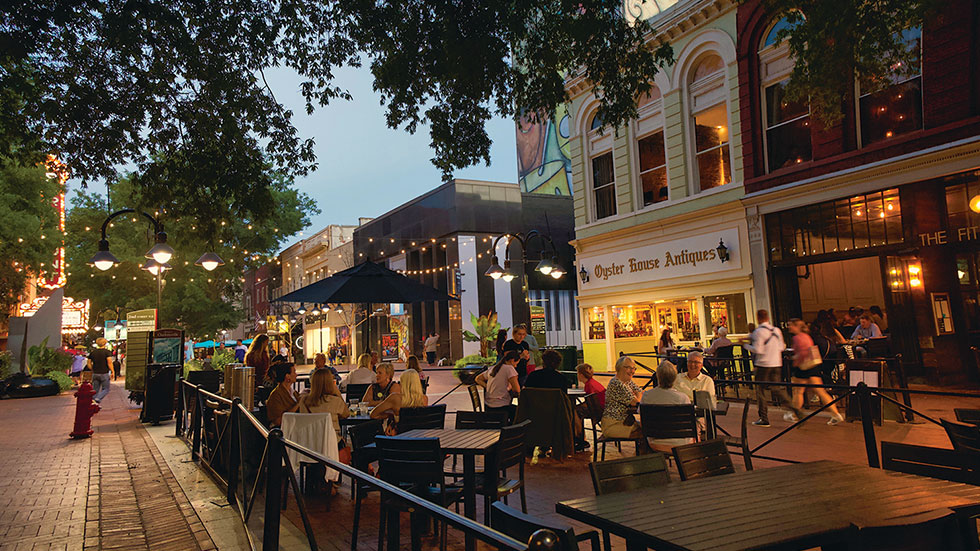 Enjoy alfresco dining in Charlottesville’s pedestrian mall downtown. Photo by Renee Sklarew
Enjoy alfresco dining in Charlottesville’s pedestrian mall downtown. Photo by Renee Sklarew
THE MAGNIFICENCE OF MONTICELLO
My next stop is Monticello, Charlottesville’s most notable attraction. This year marks the 100th anniversary of the opening of Thomas Jefferson’s farmstead to the public; the UNESCO World Heritage Site now attracts a half-million visitors annually.
In addition to the mansion tour, I trek through the expansive fields on the Gardens & Grounds Tour, where my guide shares that Jefferson’s household typically consumed 400 bottles of wine every year! When the farmer-in-chief tried to grow his own grapes, all 24 varieties of European vines fell prey to black rot.
In 1985, The Thomas Jefferson Foundation grafted Jefferson’s European varieties with native grapevines and produced the first 300 bottles of white wine at Monticello. Today, vintner Gabriele Rausse oversees winemaking at Monticello, where I find bottles of Monticello Claret and Monticello Chardonnay Reserve in the gift shop. Jefferson would be pleased.
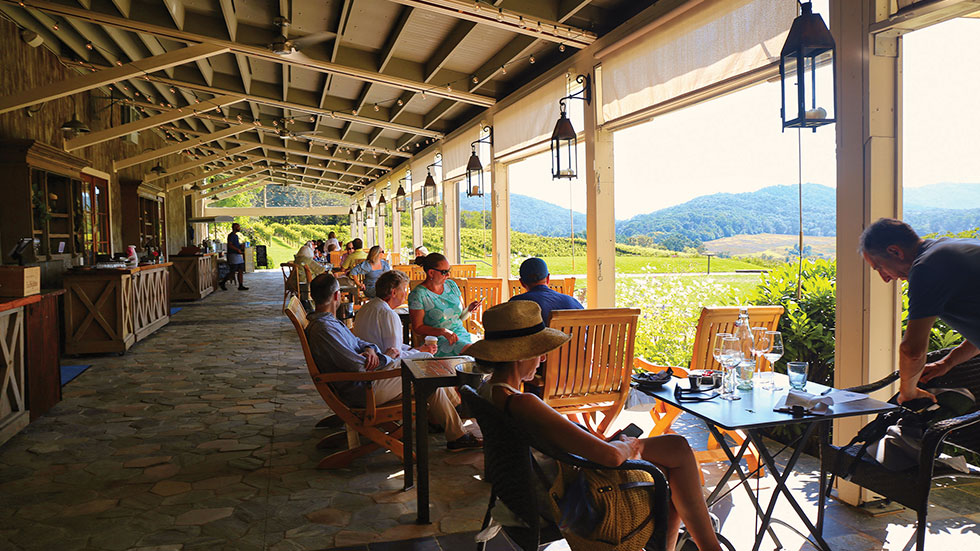 Pippin HIll Farm and Winery. Photo by Renee Sklarew
Pippin HIll Farm and Winery. Photo by Renee Sklarew
A BLEND OF OLD AND NEW
While Charlottesville is recognized as Virginia wine country, the city has a wealth of dining options, from the historic 18th-century Michie Tavern to The Ridley, a sleek restaurant in The Draftsman Hotel.
I stroll down Charlottesville’s pedestrian mall, checking out the 30 restaurants on either side of the brick walkway. I choose an outdoor table at the Belgian-inspired Brasserie Saison and order the bitterballen to start. Buttery brisket comes fried in a crisp panko crust, followed by an entree of scallops and local cheeses for dessert.
After dinner, I return to my posh room at Quirk Charlottesville, an über-modern downtown hotel bedecked in pink with contemporary art. It’s still early, so I head to Quirk’s rooftop bar, an indoor-outdoor space with views of the city and the Blue Ridge Mountains in the distance.
Perched on a slouchy couch, I sip a glass of viognier from Barboursville Vineyards, the first winegrower to establish vines in Virginia in 1976. I’ve always enjoyed the complex, perfumy chardonnay-like wine considered the area’s signature grape.
The next morning, I walk to MarieBette Café & Bakery and line up behind customers buying boxes of still-warm pastries. The aroma of vanilla and roasted coffee welcomes me in the doorway, where I blink to make sure I’m not in France.
It’s nearly impossible to choose between the crusty sourdough breads and the viennoiserie, all made with ingredients sourced from nearby farms. So, I purchase a selection to bring home.
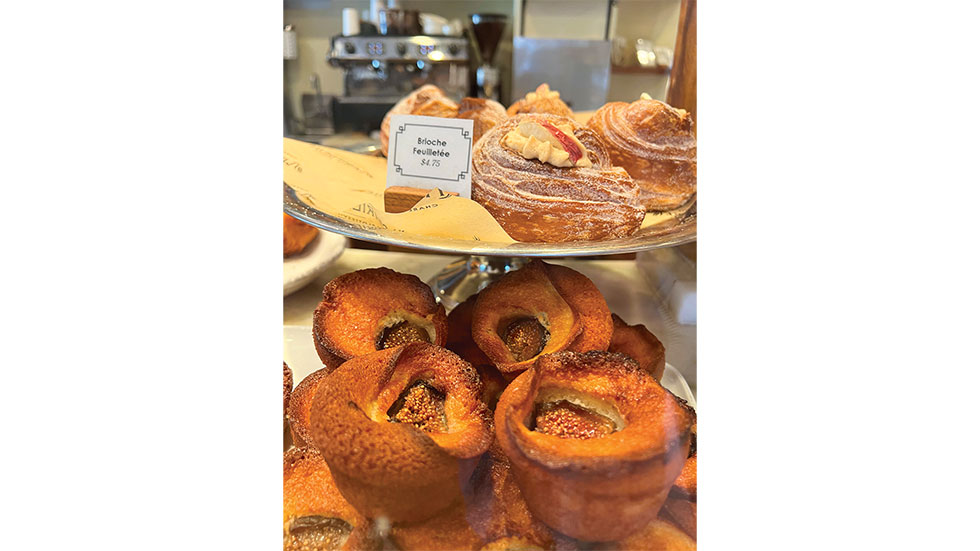 Baked goods at MarieBette Café & Bakery. Photo by Renee Sklarew
Baked goods at MarieBette Café & Bakery. Photo by Renee Sklarew
FOOD: OUR COMMON GROUND
There’s no more intriguing place to dine than Charlottesville’s Dairy Market. Built in 1937, the original market sold ice cream, milk and eggs. The building reopened in December 2020 as a vibrant food hall.
As we walk through the market, Anna Payne, director of marketing, lists a world of options: “We have 17 vendors, including Filipino food, tacos, ramen, vegan fare, burgers, and ice cream from MooThru. We have a bar called Milkman’s, and there’s Starr Hill Brewery.”
After much deliberation (and salivation), I order lunch from Angelic’s Kitchen, a soul food eatery known for its fried fish. The crispy whiting comes with two sides, so I choose tangy collard greens and mac and cheese.
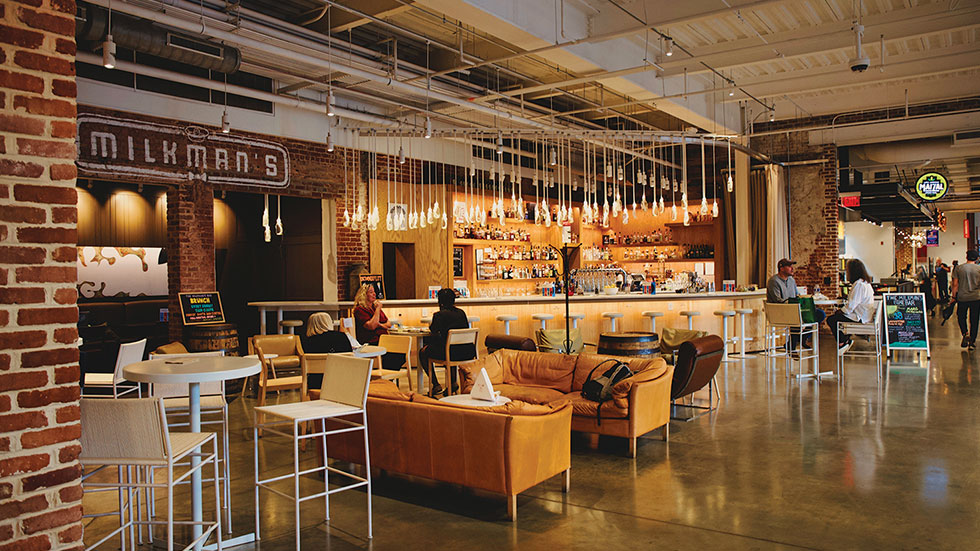 Dairy Market food hall. Photo by Renee Sklarew
Dairy Market food hall. Photo by Renee Sklarew
While I’m eating, I notice students from the University of Virginia sitting alongside families, seniors and workers on their lunch break. I comment that Dairy Market feels like a community unto itself. Payne agrees, “We have changed the way Charlottesville goes out.”
Another festive gathering space is Charlottesville’s new Ix Art Park, tucked inside a renovated textile mill. People meet here for the weekly farmers market, free art programs and food festivals. The main attraction, though, is The Looking Glass, where glassmakers, sculptors, and light and sound technicians have created several immersive spaces. In one magical room, I duck in delight as silk tendrils—remnants of the parachutes once made in the mill—tickle my ears.
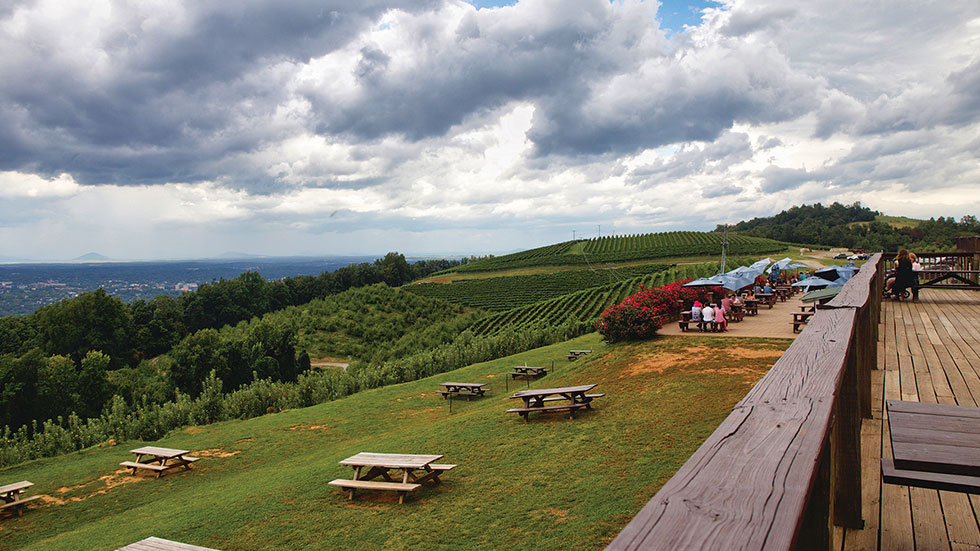 Carter Mountain Orchard. Photo by Renee Sklarew
Carter Mountain Orchard. Photo by Renee Sklarew
BLOOM AND GROW
My last stop is Carter Mountain Orchard, situated atop a mountain overlooking apple and pear trees. I’ve come here for the orchard’s featured treat: cider donuts. The donuts arrive hot from the fryer, with cinnamon and sugar enveloping the sweet apple cake inside. I add a glass of Carter Mountain Rosé and observe Charlottesville spread out below.
Over the next hill is Monticello. Two hundred years later, Jefferson’s vision of this area as a place to cultivate wine has been fulfilled. I toast to that.
